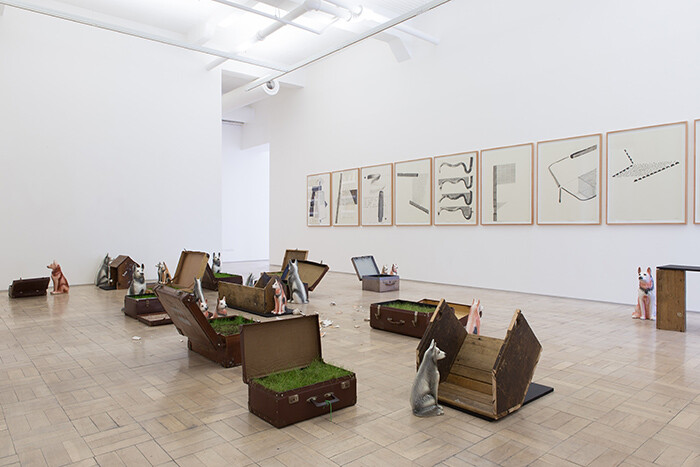If mourning is a working-through of past history, a process that, if effective, results in a letting go, then South African-born Kemang Wa Lehulere embodies the melancholic, the subject who refuses to release the lost object; a grieving subject whose pain knows no end.
When considering the work of Kemang Wa Lehulere, it seems he too belongs to a long tradition of artists born under Saturn.1 His oeuvre consistently maintains a multitude of links to the past and his current exhibition at Stevenson Gallery in Cape Town is no exception, standing as an example of a tangled, febrile, visual story told in parts. Densely populated, perhaps in excess, by the plethora of mediums he uses—ranging from sculpture and photography to large oneiric chalk drawings on walls, to works on paper and smaller, alternately protruding blackboards with further drawings—the artist exhumes the ruins of Apartheid, digging into the compacted sands of history as he literally does in the video piece Homeless Song 2 (2015). In this work, a shirtless Wa Lehulere uses a rather fragile-looking music stand as a tool to displace the fine yellow dust on a privately-owned Johannesburg mine dump. The act comes to an abrupt end with the arrival of a security guard. These ghosts—the unnamed laborers, the victims at Marikana, and the exiled journalist Nathaniel Ndazana Nakasa, known here as Nat—seem to hold a special claim over the artist’s work.
Born in 1937 and raised before the implementation of the Group Areas Act and other pernicious segregation laws in South Africa, Nakasa was to become an accomplished writer, editor, and literary flâneur who walked the streets of cosmopolitan Johannesburg and its surrounds, reputedly traversing the “color bar,” which prohibited the mixing of whites and blacks, with apparent oblivion and nonchalance. An agitator of rules with his tactics of habitat—Nakasa refused to leave the city and move to the township—he was a regular contributor to The Golden City Post, assistant editor of the important Drum magazine, the first black columnist on the Rand Daily Mail and founder of The Classic, a quarterly publication of stories and poems. But with intensified censorship in 1960s South Africa, Nakasa’s rapid ascension amongst the country’s literary ranks was drastically curbed. In 1965 he was invited to join a class of Nieman fellows at Harvard University, but after being denied a visa after months of waiting he took the desperate avenue of no return—an exit permit—to become stateless, a native of nowhere. Emotionally wounded, expendable, endangered, and depressed, like dozens of others, a year after his arrival in the US, disillusioned by the stifling of Black America Nakasa plunged to his death from the seventh floor of a Central Park West apartment.
“To whom it may concern” deftly carries the memory and trace of Nakasa by way of a number of signifiers, such as a tennis racket and a brown Globalite school case, some of the objects the writer is said to have transported on his first journey from his home in the Eastern Cape to Johannesburg; tokens of sophistication that he is also known to have sported on his first infamous visit to the offices of Drum. Multiplied to form a minefield within the gallery space, these ordinary cases carry within them miniature plots of land. They evoke Wa Lehulere’s symbolic visit to the Ferncliff cemetery outside New York in 2013, where Nakasa lay buried for almost half a century, within meters of Malcolm X. On the occasion of this pilgrimage Wa Lehulere removed a patch of grass from Nakasa’s plot, intending to peregrinate with it on the long journey home. The suitcase, a powerful signifier, also evokes the fate of other apatrides such as Walter Benjamin, who on September 26, 1940 was refused entry to Spain at Port-Bou. This would be the end of the line for the mercurial philosopher, together with a mysterious, most important manuscript, forever locked in his famous black leather briefcase.
Nakasa and perhaps the artist’s own experience of the dictates of the pernicious system of Apartheid and “Bantu education” form another motif and concern, rendered in this staging of the accoutrements of learning. These apparent spaces of discipline are manned by kitsch dog figurines, won at fairgrounds in Europe, and found, according to the artist, adorning the homes of many South Africans. Positioned throughout the gallery, they seem to wait silently, almost expectantly, poised for instruction besides model houses made from salvaged school desks. In one particular instance, Scene 11: stage a reading (2015), a dog is missing from the row of obedient “pupils.” According to a local belief, the sleeping dog has access to an alternate, spiritual realm. Wa Lehulere, I would venture, suggests that we make this sleeping dog’s vision, this dreaming, our own. Lest we forget that the past is present, no other fate awaits us besides that of ruination.
A term used by Margot and Rudolf Wittkower in their book Born Under Saturn: The Character and Conduct of Artists (New York: Random House, 1963).








